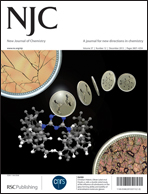Intriguing sensing properties of a di-tripodal amine calix[4]arene ionophore towards anions from Donnan failure in ion-selective membranes induced by Cu2+†
Abstract
In this paper, di-tripodal amine calix[4]arene, L1, was successfully synthesized and used as an ion carrier in poly(vinyl chloride) (PVC) membrane electrodes. Compound L1 was employed to demonstrate a new concept in anion sensing by preparing an allosteric PVC membrane that can respond selectively to a certain anion in the presence of a metal effector. Membranes containing compounds L1 and potassium tetrakis(p-chlorophenyl)borate (KTpClPB) as an ionic additive showed Donnan exclusion failure upon measuring the potential (EMF) responses of Cu2+ and responded to the co-anion by giving negative EMF changes, while membranes containing compound L2, an anthracene-based mono-tripodal amine ligand, gave positive potentials to most metal ions. Upon preconditioning of the membranes containing L1 and 75 mol% KTpClPB in CuCl2, the membranes showed the highest selectivity towards thiocyanate with a near Nernstian slope of −59.6 mV decade−1, a 10−5 to 10−2 M linear range, and a detection limit of 4.4 × 10−6 M. The best allosteric membrane can be used in the pH range 3–7 with good reversibility, and also applied to indirectly determine the concentration of Fe3+ in aqueous solution.
![Graphical abstract: Intriguing sensing properties of a di-tripodal amine calix[4]arene ionophore towards anions from Donnan failure in ion-selective membranes induced by Cu2+](/en/Image/Get?imageInfo.ImageType=GA&imageInfo.ImageIdentifier.ManuscriptID=C3NJ00748K&imageInfo.ImageIdentifier.Year=2013)

 Please wait while we load your content...
Please wait while we load your content...